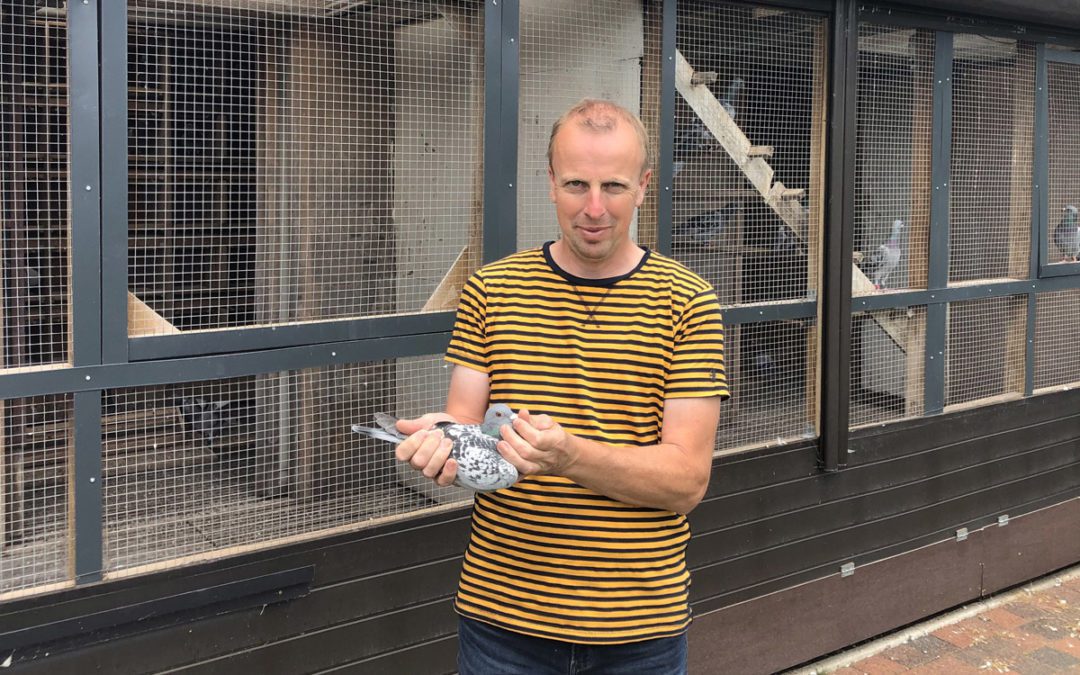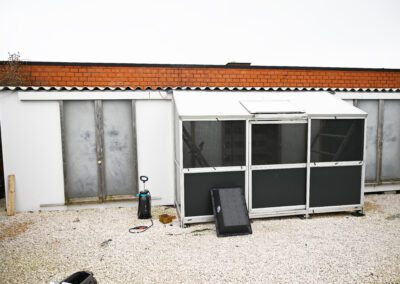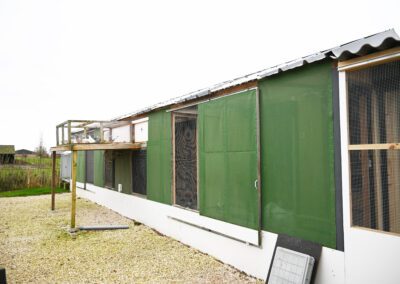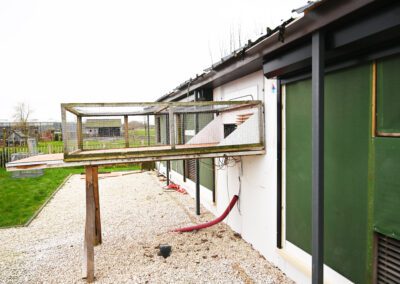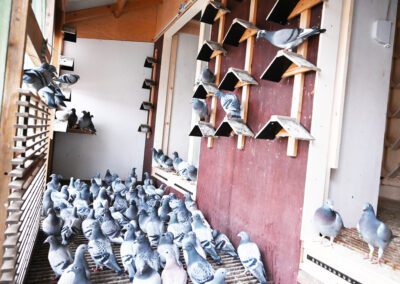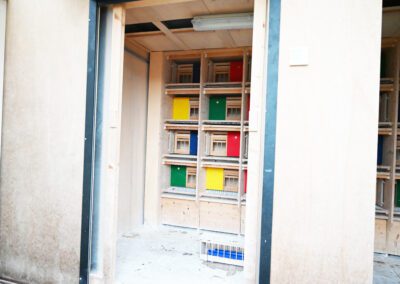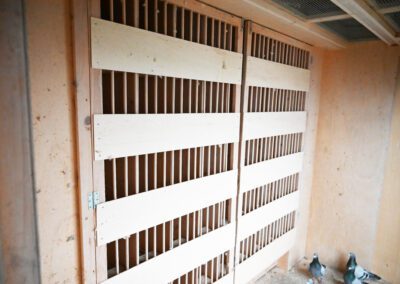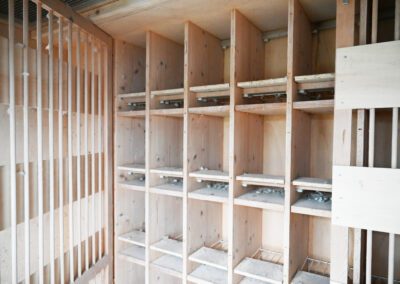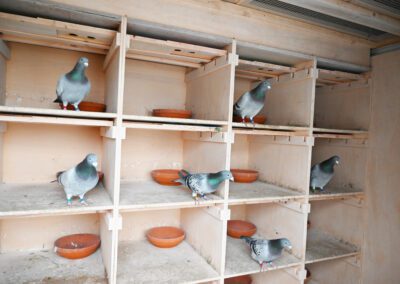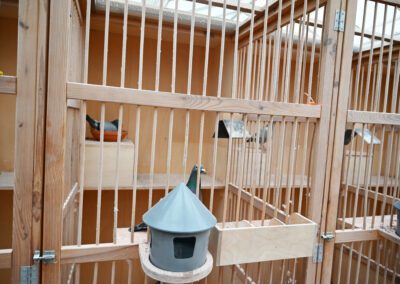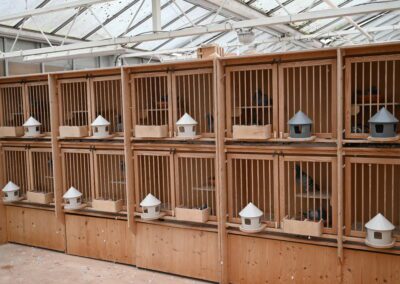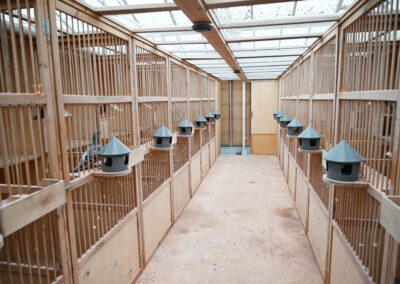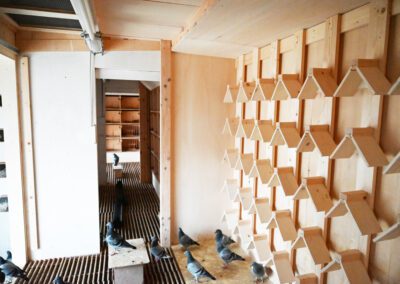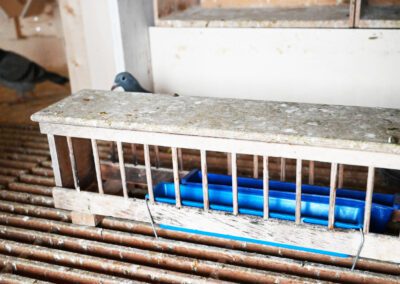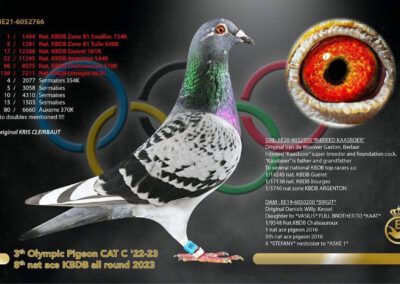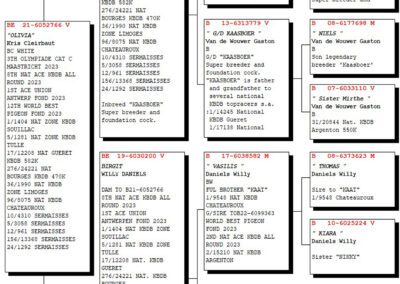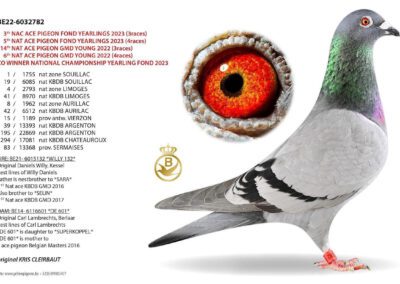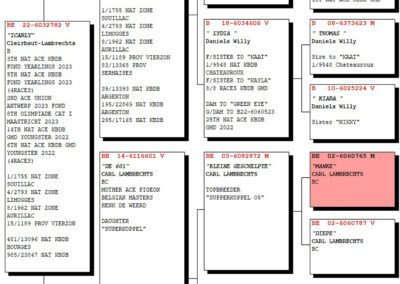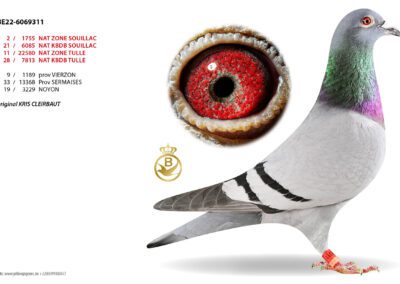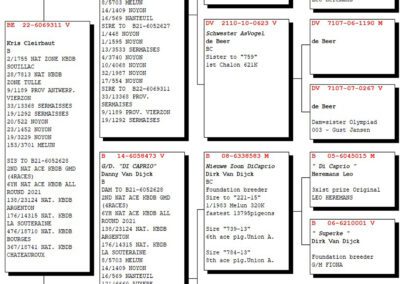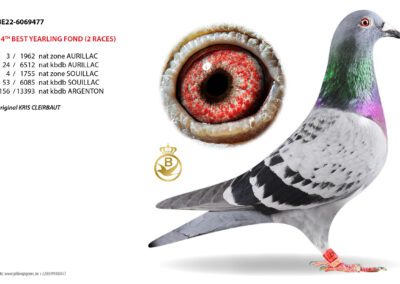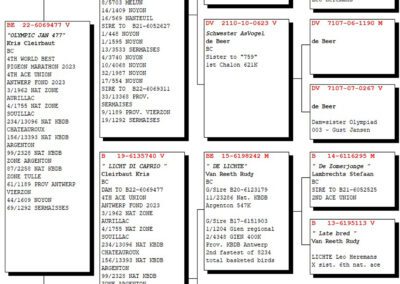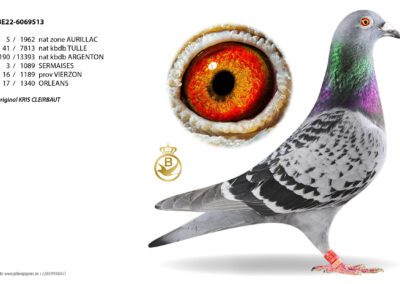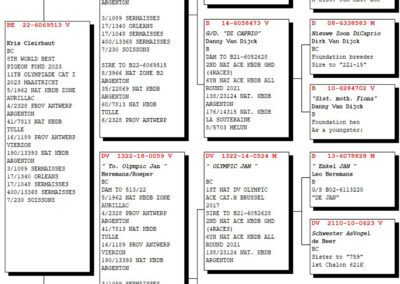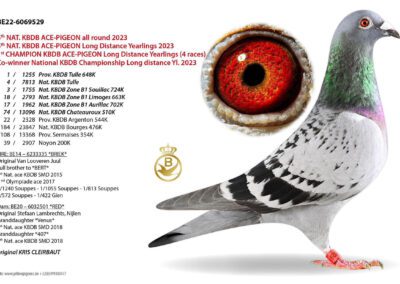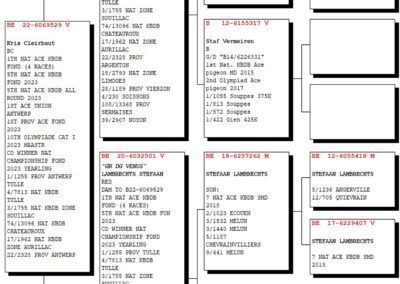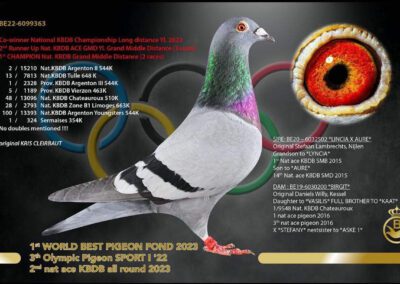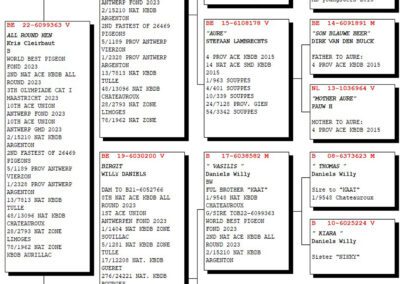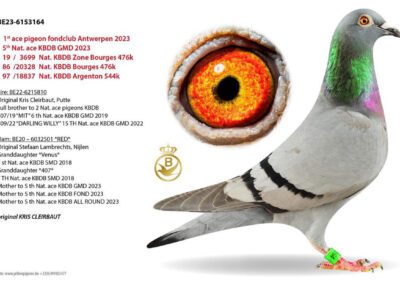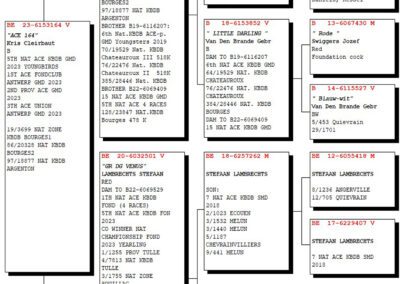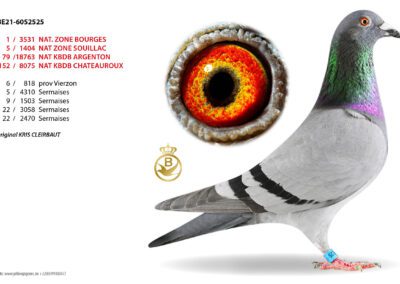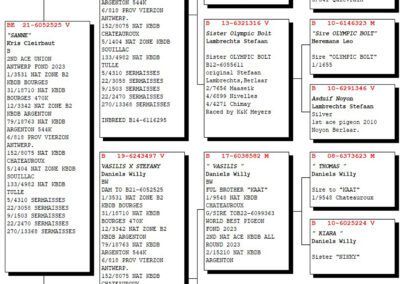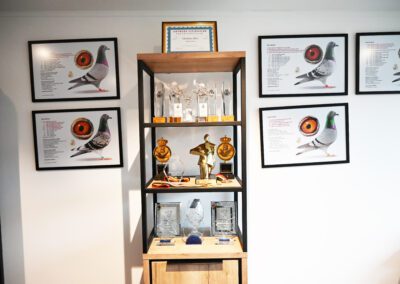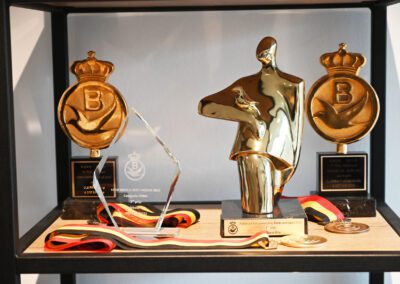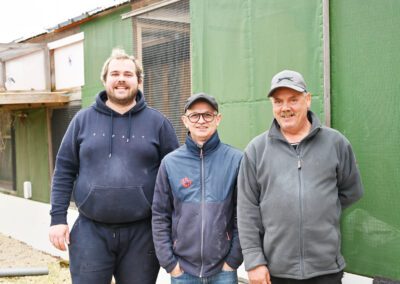This is the last report about the racing season 2021. From next month on we will report about the national KBDB winners of the racing season 2022
Young Kris Van Massenhoven was first introduced to pigeons when, as a 6-year-old boy, he was groomsman to a wedding couple. As a reward, he was given four pigeons, but the pigeons were released and left with the sun. A few years later, in the first year of study, Kris had Frans Proost as a teacher, and he was also the chairman of the “Blauwe Duif”. He assured Kris that if a certain pair had two red youngsters in the nest, then they were for him. They were two red youngsters, and the cock was christened “Franske” and the hen “Hilda” or Frans Proost’s wife. “Hilda” was soon gone but “Franske” was a good flyer and a good breeder and became the progenitor of this young colony. He became father of the “464” with 22 first prizes and that in turn became father of a clapper with 15 first prizes and that became father of the “198” that made it to provincial champion. Pigeons from Frans Proost, Retie; Jan Van Oeckel, Oud-Turnhout and Jos Van Gorp, Oud-Turnhout then formed the basis with Kris Van Massenhoven. In 1999, Kris became 6th National Short distance Champion. In 2000 he was 3rd National Short distance Champion and in 2001 he was 1st National Short distance Champion. But then things went downhill because, as an enthusiastic young fancier, he had sold too many of his good pigeons.
Between 2002 and 2006, he made the switch to middle-distance. In 2008, Kris then started getting eggs from Frans Van Gorp, Oud-Turnhout. In 2009, he was on the doorstep of Danny Van Dyck, Pulle.
The 920/11 “Schone Dirk” became the new progenitor of the colony and was paired with Danny Van Dyck’s “159/09”. Kris had learned his lesson and no more pigeons were sold from the foundation pair.
In 2012, Kris bought a voucher from Gust Van Hove, Retie and it is the mother of the “Raketje”. Gust quit pigeons in 2019 and they were sold in the local and Kris then bought 10 pigeons. With 3 pigeons, he did very well.
In 2017, 10 pigeons were added from André Roodhooft, Pulderbos. Also in 2017, Father Fons went to feed and release pigeons for two years from Danny Dockx, Oud-Turnhout. Danny had then bought a round from Niels Broeckx, Oud-Turnhout and among them was a sister of the Olympiad pigeon “306”. And Kris then did some co-breeding with Danny. He then bred a pigeon that is the sire of the 1st Nat. Ace Pigeon Speed Yearling 2021.
In 2019 it was the turn of the Gebr. Van den Akkerveken, Oud-Turnhout and also with these pigeons Kris has already succeeded very well.
The backbone of the current colony is formed by pigeons from Dirk Van den Bulck, Danny Van Dyck and Gust Van Hove. Every winter another coupon is bought left and right.
They play on 36-metre lofts, including 4 m for the widowers, 8 m for the hens, 16 m for the youngsters and 8 m for the breeders. The garden is full of lofts and across the street another loft was added for the youngsters. They are not insulated garden lofts. The new loft for the youngsters has an aviary with shutters at the front. When it rains, these are partially lowered to keep the aviary dry. The ceiling of the garden lofts is three-quarters closed with one-quarter wire. Fresh air intake is under the gutter.
Twice a day the lofts are cleaned and a major clean is scheduled once a year. In the new loft, the pigeons sit on wooden slats, and it is equipped with manure conveyors. There is little glass in the lofts.
The widowers
The widowers are paired in mid-December and raise two youngsters. They come back with eggs around 15 March and brood for 3 to 4 days. Then they leave on widowhood. Rearing is quick and after 4 feedings the job is done. Six birds are played on Quiévrain, six birds are played on Noyon and eight birds on the middle distance.
The pigeons train three quarters to an hour twice a day. The way they train is important and they need to be in good spirits. When basketing, the cocks come together with their hens for 5 to 10 minutes and no extra motivation is sought. After arriving from a race, the partners stay together for two hours.
Hens
Of this team, 8 hens are played on total widowhood with the 8 cocks that fly middle distance. The pairs on total widowhood raise a pair of youngsters. On 15 March, they are coupled again and allowed to incubate for 3 to 4 days.
The 22 hens on total widowhood are paired for a week and had no eggs and then left on widowhood. This method has suited Kris very well and is definitely worth repeating.
The hens train 2x daily for 3 quarters of an hour to an hour. It is not compulsory training but sitting on the roof is equivalent to calling them in.
Rearing is also a quick job with 4-5 feedings and at basketing the partners meet for half an hour. After a race arrival, cocks and hens stay together for 2-3 hours.
The eight hens on total widowhood sit on shelves with a net about half a meter above the ground. For the other 22 hens, the living boxes are closed, and the pigeons sit on shelves in front of the nest boxes. These hens sit on wooden grids.
There are few problems with mating among themselves. The warmest hens are then taken from the loft when they are not performing well. Playing the hens every week is a good remedy against mutual mating.
Toppers of the 2021-2022 season
BE 20-6090616 “Wout” Duiver
1st National Ace short distance yearbirds KBDB 2021
19th National Ace short distance young birds KBDB 2020
1 Quievrain 584b
1 Quievrain 554b
1 Quievrain 452b
1 Quievrain 409b
1 Quievrain 223b
3 Quievrain 3,026b
3 Quievrain 1,014b (1-273b)
3 Quievrain 266b
4 Quievrain 594b
4 Quievrain 505b
5 Quievrain 764b
5 Quievrain 735b
9 Quievrain 358b
11 Quievrain 546b
15 Quievrain 586b
BE 21-6092303 “Remco” Duiver
1 Quievrain 892b
1 Quievrain 330b
1 Quievrain 328b
3 Quievrain 491b (after 2 loft mates)
3 Quievrain 455b
3 Quievrain 307b (after 2 loft mates)
The young force
250 youngsters are bred from breeders and racers and are weaned at 24 days of age.
The youngsters are darkened from mid-March to 21 June from 5 p.m. to 8.30 a.m. Additional lighting is provided from 21 June until the end of the season. Training the youngsters is quite a job. They are taken away very often, 15 to 20 times. From July onwards, once they have been trained, they are transported again every week up to 60 km.
The sliding door is introduced when the youngsters have raced Quiévrain 2 to 3 times. When basketing, the sliding door simply opens but without boxes or nest dishes on the loft. Only the living boxes open. A healthy youngster with “form” flies on everything without extra motivation and can do a lot.
The youngsters train twice a day and from July with the flag and have to stay in the air for 1 hr.
Nutrition and medical
Kris continues, “I buy one bag of diet mix every year for the whole year if the youngsters had to get adeno. When they arrive from a race, the pigeons find sports mix in the feeder. From home to basketing, only sport mixture is fed, and this is bought from three well-known brands. At the beginning of the week, a smaller portion is fed and as the week progresses, the portion becomes larger.
Optimix by Herbots is also provided (vitamins). Herbo Elite Pigeon is also given on Monday and Wednesday. Two days before basketing we give Herbo CMB plus and on Tuesday and Thursday evening Golden Omega Oil by Vincent Schroeder. On race arrival, there is Tollyamin Forte by Vincent Schroeder in the drinking water.”
“I consult different vets with different opinions on pigeon diseases. For the big middle distance, yellow drops are provided through the beak.
During breeding, 1x five-day treatment was given against trichomonas and this was not repeated during the season. The old pigeons were not treated against respiratory infections. The youngsters were treated against respiratory infections before the season.
Eye drops were administered in July and August for one eye cold. I also give the pigeons condition syrup from vet Mariën once a month.
Every year, the youngsters face adeno with the exception of 2021. The youngsters were vaccinated twice against paramyxo. At weaning, they were vaccinated against paramyxo with the normal vaccine and three weeks later with Paramyxo-Rota. Another three weeks later, they were vaccinated against smallpox with the brush.
From 1 October, all pigeons were treated against paratyphoid for 10 days but not vaccinated.”
Breeding pigeons
At the end of November, the breeders are paired for the first time, and they breed four rounds of youngsters. Eight pigeons are in breeding boxes and the eggs are shifted among stop couples. After laying the eggs, the pigeons are separated for three days, and the cocks get another hen in their nest box. There is limited family breeding.
Selection among the breeders is quite strict. After two years, there must be something from the pair that performs, otherwise the residence permit will expire. Sporadically pigeons are brought in. There is also compensation pairing and a big cock gets a small hen. Eyes and wing play no role in pairing. Fourteen days before pairing, the pigeons are given light to stimulate the drift. Pre-mating is done. The pigeons are given light until the youngsters are weaned.
The pairings usually happen well x well, but the fancier sometimes gets surprises, says Kris.
The basket does the selection
In selection, prices per dozen are the norm but even here a surprise is not out of the question. The “853/20” flew 1 flat prize as a young pigeon. But it was a beautiful pigeon with a good pedigree, and he was kept on. In 2021, he emerged as a real winner. In selection, the top prizes are important, and the second half of the result does not count. A pigeon must be well made and prizes per 10 are the norm for both old and young pigeons.
